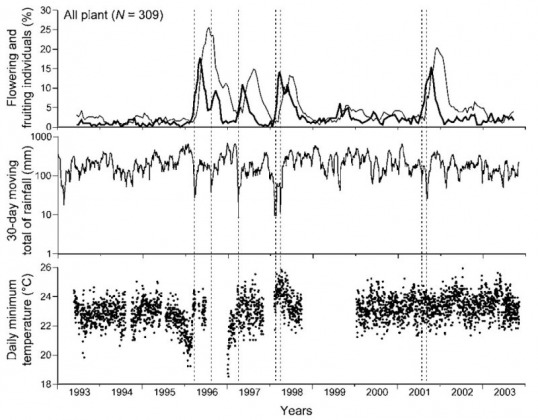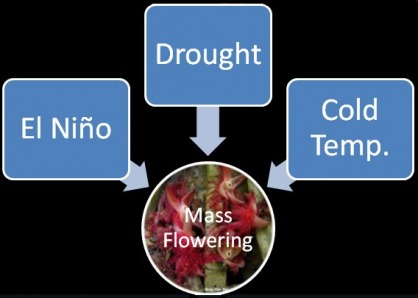Cues in mass flowering of Dipterocarpaceae
Background and Rational
Dipterocarps are a well known family of trees common to the tropics. This forest type has been extensively studied in aseasonal tropics of Southeast Asia as it exhibits an unusual and particular phenology. They display community wide synchronized flowering and subsequent fruiting which occur irregularly in intervals of 2-10 years (Appanah 1993, Sakai 2002). Table 1 below shows flowering and fruiting frequencies in different regions and sites of Southeast Asia (Wich et al. 2000).
Table 1: Probability of masting in various SE Asian sites and areas calculated by dividing
mast fruiting years by the numner of observations. Source: Wich and Van Schaik 2000.
mast fruiting years by the numner of observations. Source: Wich and Van Schaik 2000.
These mass flowering (MF) and subsequent mast-fruiting (SMF) can involve as many as 200 species of dipterocarp trees (Appanah 1993, Sakai 2002). Also, trees from related families are known to participate in mass flowering along with Dipterocarpaceae, making mass flowering both inter – and intraspecifically synchronized (Appanah 1993). Particularly strong flowering events have been noted to occur over a vast regional space (Appanah 1993). Yet, they could be highly localized. These events appear to be unpredictable in nature and there has been much debate about the factors that trigger them. This unpredictable mass flowering poses a difficulty for regeneration and management of this forest type as their seeds are only viable for a few weeks after they are shed. For best forest management practices, predicting the onset of flowering of dipterocarps would help in deciding accurate harvesting times of these trees without loosing the chance for their reproduction.
Photo 2: A variety of wildlife that depends on Dipterocarp forest for flower pollen or fruit. Many are endemic and endangered.
Photo credit: Mariya Chechina and www.animalpicturesarchive.com.
Photo credit: Mariya Chechina and www.animalpicturesarchive.com.
It has been agreed that mass flowering is an evolved strategy that benefits the trees by lowering predetaor populations in the years when no fruits are produced and satiating them during mass flowering years. Large mass flowering events also benefit the plants by increasing cross pollination success (Appanah 1993, Curran and Leighton 2000, Curran and Webb 2000, Sakai 2002). Even though the evolutionary advantage of mass flowering is very clear, it still remains a mystery of how the trees of 200 different species synchronize reproduction. Studies of dipterocarps in Peninsular Malaysia and in Borneo found a correlation of flowering with El Niño events (Ashton et al. 1988, Curran et al. 1999). See Figure 1 below (Ashton et al. 1988, Curran et al. 1999).
Figure 1: Correlation of El Niño and masting in West Kalimantan, Borneo. Red bars
represent El Niño and blue bars represet La Niña years with yellow circles representing
export levels of Diterocarp seeds. Source: Curran et al. 1999.
represent El Niño and blue bars represet La Niña years with yellow circles representing
export levels of Diterocarp seeds. Source: Curran et al. 1999.
Other studies, however, found that flowering was not correlated with El Niño, but it was rather either a prolonged and unusual drought or a drop in a minimum night time temperature as seen in Figure 2 below (Numata et al. 2003, Sakai et al. 2006, Brearley et al. 2007). It appears that the same family of trees which exhibits the same flowering pattern responds to different environmental cues. And this leads into the research questions for this project.
Figure 2: Mass flowering events and weather patterns. Source: Sakai et al. 2006.
Research Objectives
1. To establish a spatial pattern of weather and flowering cues in different regions in Southeast Asia.
2. To investigate a weather cue of dipterocarp flowering in Southeast Asia in order to identify a possible common trigger.
3. To predict future flowering events.
2. To investigate a weather cue of dipterocarp flowering in Southeast Asia in order to identify a possible common trigger.
3. To predict future flowering events.
Expected Results
I expect to find a correlation between El Niño and mass flowering in Borneo and East Peninsular Malaysia as predicted by Wich and van Schaik, 2000. In other parts of Malesia, I expect to find weather cues that simulate El Niño conditions. It has been shown that El Niño causes exceptional drought in Southeast Asia with strongest impacts in East Borneo. These impacts weaken towards the West (Wich and van Schaik 2000). There fore, a combination of weather events that create drought like conditions are expected to cue mass flowering in dipterocarps.
References
Appanah, S. 1993. Mass Flowering of Dipterocarp Forests in the Aseasonal Tropics. Journal of Biosciences 18:457-474
Ashton, P.S., T.J. Givnish, and S. Appanah. 1988. Staggered Flowering in the Dipterocarpaceae – New Insights into Floral Induction and the Evolution of Mast Fruiting in the Aseasonal Tropics. American Naturalist 132:44-66.
Brearley, F.Q., J. Proctor, Suriantana, L. Nagy, G. Dalrymple, and B.C. Voysey. 2007. Reproductive Phenology Over a 10 Year Period in a Lowland Evergreen Rain Forest of Central Borneo. Journal of Ecology 95:828-839.
Curran, L.M., and M. Leighton. 2002. Vertebrate response to Spatiotemporal Variation in Seed Production of Mast-Fruiting Diterocarpaceae. Ecological Monographs 70:101-128.
Curran, L.M., and C.O. Webb. 2000. Experimental Tests of the Spatiotemporal Scale of Seed Predation in Mast-Fruiting Dipterocarpaceae. Ecological Monographs. 70:129-148.
Numata, S., M. Yasuda, T. Okuda, N. Kachi, and N.S.M. Noor. 2003. Tempral and Spatial Patterns of Mass Flowerings in the Malay Peninsula. American Journal of Botany 90:1025-1031.
Sakai, S. 2002. General Flowering in Lowland Mixed Dipterocarp Forests of South-East Asia. Biological Journal of the Linnean Society 75:233-247.
Sakai, S., R.D Harrison, K. Momose, K. Kuraji, H. Nagamasu, T. Yasunari, L. Chong, and T. Nakashizuka. 2006. Irregular Droughts Trigger Mass Flowering in Aseasonal Tropical Forests of Asia. American Journal of Botany 93:1134-1139.
Wich, S.A., and C.P. Van Schaik. 2000. The Impact of El Niño on Mast Fruiting in Sumatra and Elsewhere in Malesia. Journal of Tropical Ecology 16:563-577
Ashton, P.S., T.J. Givnish, and S. Appanah. 1988. Staggered Flowering in the Dipterocarpaceae – New Insights into Floral Induction and the Evolution of Mast Fruiting in the Aseasonal Tropics. American Naturalist 132:44-66.
Brearley, F.Q., J. Proctor, Suriantana, L. Nagy, G. Dalrymple, and B.C. Voysey. 2007. Reproductive Phenology Over a 10 Year Period in a Lowland Evergreen Rain Forest of Central Borneo. Journal of Ecology 95:828-839.
Curran, L.M., and M. Leighton. 2002. Vertebrate response to Spatiotemporal Variation in Seed Production of Mast-Fruiting Diterocarpaceae. Ecological Monographs 70:101-128.
Curran, L.M., and C.O. Webb. 2000. Experimental Tests of the Spatiotemporal Scale of Seed Predation in Mast-Fruiting Dipterocarpaceae. Ecological Monographs. 70:129-148.
Numata, S., M. Yasuda, T. Okuda, N. Kachi, and N.S.M. Noor. 2003. Tempral and Spatial Patterns of Mass Flowerings in the Malay Peninsula. American Journal of Botany 90:1025-1031.
Sakai, S. 2002. General Flowering in Lowland Mixed Dipterocarp Forests of South-East Asia. Biological Journal of the Linnean Society 75:233-247.
Sakai, S., R.D Harrison, K. Momose, K. Kuraji, H. Nagamasu, T. Yasunari, L. Chong, and T. Nakashizuka. 2006. Irregular Droughts Trigger Mass Flowering in Aseasonal Tropical Forests of Asia. American Journal of Botany 93:1134-1139.
Wich, S.A., and C.P. Van Schaik. 2000. The Impact of El Niño on Mast Fruiting in Sumatra and Elsewhere in Malesia. Journal of Tropical Ecology 16:563-577





